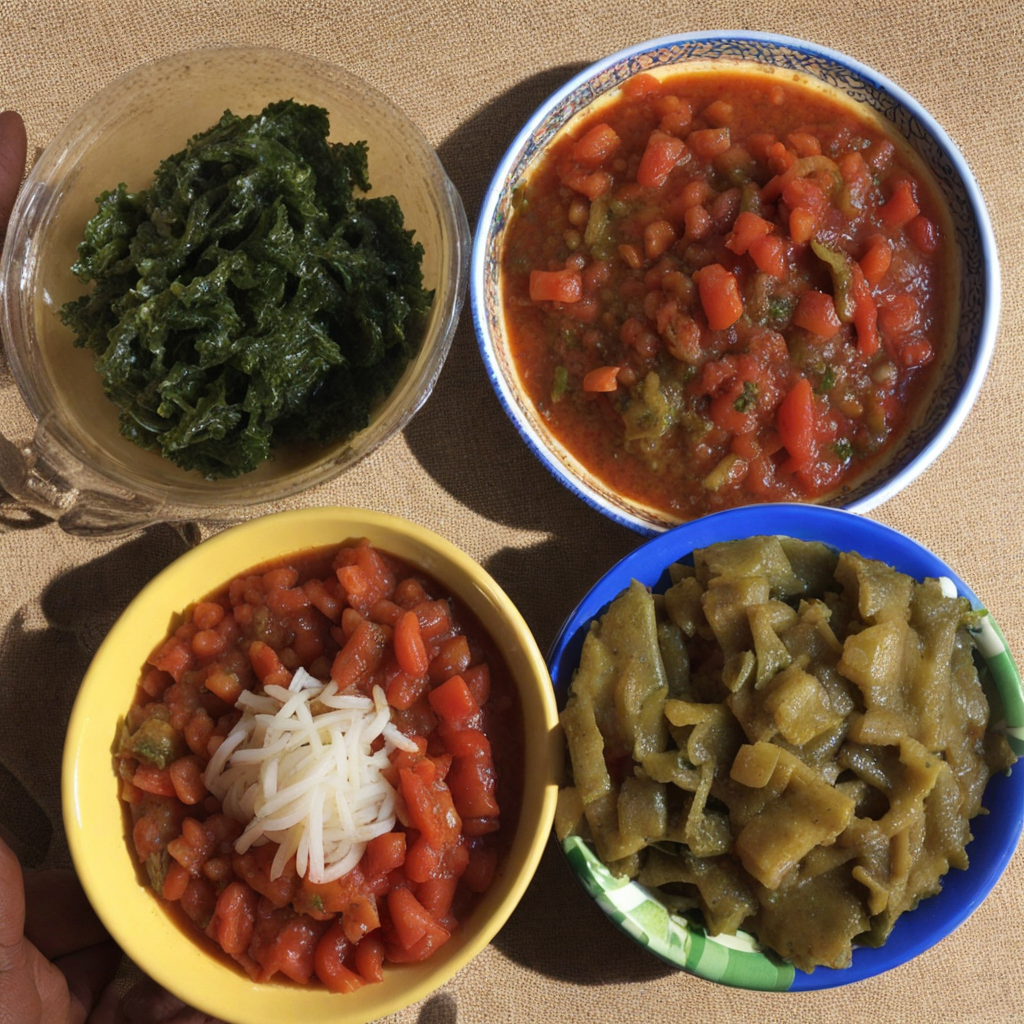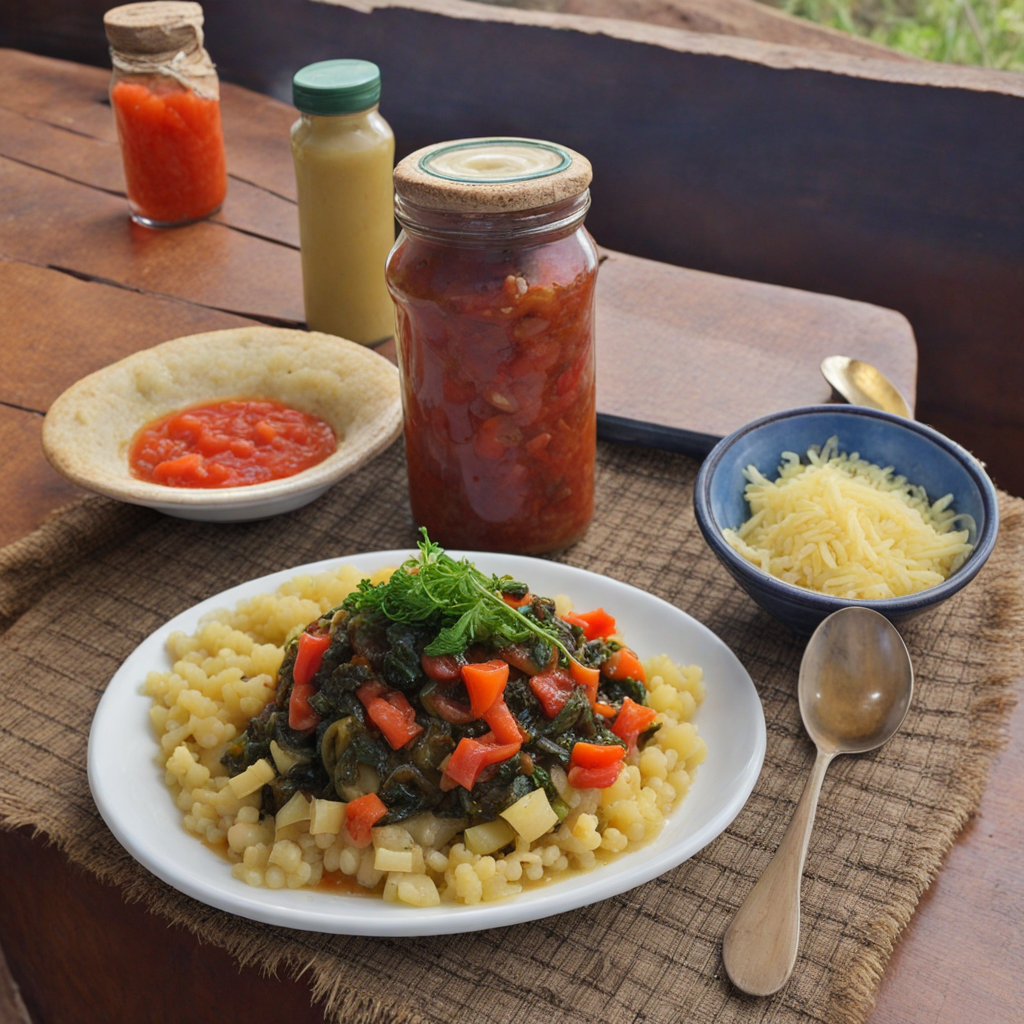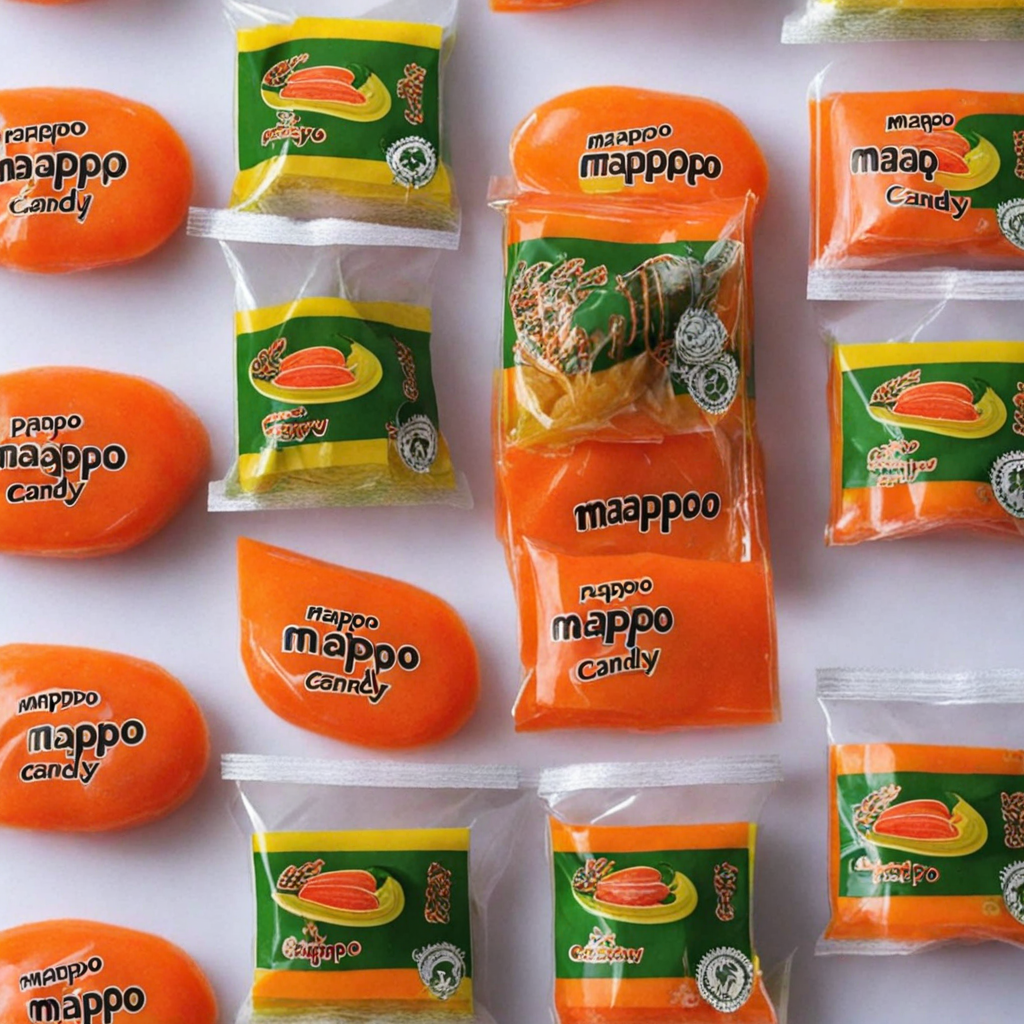Usavi Wemuriwo
Usavi Wemuriwo is a vibrant and hearty dish from Zimbabwe that showcases the country's rich agricultural heritage. At its core, it features a medley of leafy greens, often including collard greens (known as 'muriwo') or other seasonal vegetables, sautéed to perfection. The greens are typically cooked with onions, tomatoes, and a hint of garlic, creating a fragrant base that enhances the natural flavors of the vegetables. The dish is often enriched with ground peanuts or peanut butter, adding a creamy texture and a nutty depth that makes each bite a delightful experience. What sets Usavi Wemuriwo apart is its versatility; it can be served as a main dish or a side, complementing staples like sadza—a thick porridge made from maize meal. The earthy, slightly bitter notes of the greens are beautifully balanced by the richness of the peanuts, providing a satisfying contrast that appeals to the palate. Some variations may also incorporate spices such as paprika or chili for a gentle kick, while others might include a protein source like beef or chicken, making it a complete meal. Beyond its taste, Usavi Wemuriwo is a reflection of communal dining in Zimbabwean culture, often enjoyed during family gatherings or special occasions. It embodies the philosophy of slow cooking, with ingredients simmered together to create a dish that is both nourishing and flavorful. As you explore this culinary gem, you'll discover how Usavi Wemuriwo not only provides a unique taste of Zimbabwe but also connects you to its people and traditions through the shared love of food.
How It Became This Dish
Usavi Wemuriwo: A Culinary Journey Through Zimbabwe’s Heart and Soul Origins: A Nutritional Staple of the Land Usavi Wemuriwo, often translated as "vegetable stew," holds a special place in the culinary landscape of Zimbabwe. This dish is not just a meal; it is a reflection of the cultural heritage and agricultural practices that have shaped the lives of the Zimbabwean people for centuries. The origins of Usavi Wemuriwo can be traced back to the indigenous communities of Zimbabwe, where agriculture has been a cornerstone of survival and community life. The staple ingredients of this dish usually include a variety of leafy greens, such as collard greens (muriwo), spinach, or amaranth, combined with other vegetables like tomatoes, onions, and sometimes groundnuts or beans for added protein. These ingredients are often locally sourced, reflecting the seasonal cycles and the rich biodiversity of Zimbabwe’s landscape. Historically, the preparation of Usavi Wemuriwo would have been a communal activity, with women gathering to harvest vegetables from their gardens, share recipes, and exchange stories. This sense of community and cooperation is deeply rooted in Zimbabwean culture, where food preparation has traditionally been a communal affair. The use of locally grown vegetables not only ensures freshness but also ties the dish to the land, highlighting the relationship between the people and their environment. Cultural Significance: More than Just a Meal Usavi Wemuriwo transcends mere sustenance; it embodies cultural identity and social values. In Zimbabwean culture, food plays a vital role in rituals, celebrations, and everyday life. Usavi Wemuriwo is commonly served with sadza, a staple maize porridge that accompanies most meals in Zimbabwe. The combination of sadza and Usavi Wemuriwo creates a balanced meal rich in carbohydrates, vitamins, and minerals, essential for the health and vitality of the community. During communal gatherings, ceremonies, and family celebrations, Usavi Wemuriwo is a dish that brings people together. It is often prepared for significant events such as weddings, birthdays, and funerals, serving as a symbol of hospitality and generosity. In many ways, the dish represents the gathering of family and friends, reinforcing social bonds and ensuring that the cultural traditions are passed down from one generation to the next. Moreover, Usavi Wemuriwo reflects the Zimbabwean philosophy of “Ubuntu,” which emphasizes interconnectedness and mutual respect among community members. The preparation and sharing of food is a way to foster relationships, build community spirit, and honor the ancestors who have come before. Development Over Time: Adapting to Changing Times As Zimbabwe has evolved, so too has Usavi Wemuriwo. The colonial period introduced new agricultural practices, crops, and cooking techniques that influenced traditional dishes. While the core ingredients remain rooted in local agriculture, the incorporation of other vegetables and spices reflects a gradual adaptation to external influences. For example, the introduction of potatoes, carrots, and bell peppers has added variety and flavor to Usavi Wemuriwo, allowing it to evolve while still maintaining its essence. In recent decades, the socio-economic landscape of Zimbabwe has undergone significant changes, particularly following the land reform policies of the early 2000s and the economic challenges that ensued. The emphasis on subsistence farming has often placed pressure on local farmers to diversify their crops, leading to a broader range of vegetables being included in Usavi Wemuriwo. This adaptability has ensured that the dish remains relevant and accessible, even in times of hardship. Furthermore, the rise of urbanization in Zimbabwe has transformed food preparation practices. With more people moving to urban areas and adopting fast-paced lifestyles, convenience and accessibility have become essential. Ready-to-cook versions of Usavi Wemuriwo, often sold in local markets or supermarkets, have emerged, allowing busy families to enjoy this traditional dish without the time-consuming process of preparation. This shift, while offering convenience, has sparked discussions about the importance of preserving traditional cooking methods and the communal aspects of food preparation. The globalization of food culture has also impacted Usavi Wemuriwo. As Zimbabweans migrate to different parts of the world, they carry their culinary traditions with them, leading to a fusion of local flavors with international cuisines. This has resulted in innovative interpretations of Usavi Wemuriwo, where it might be served alongside dishes from diverse culinary backgrounds, introducing Zimbabwean flavors to new audiences while simultaneously enriching the dish's own heritage. Modern-Day Usavi Wemuriwo: A Symbol of Resilience Today, Usavi Wemuriwo stands as a symbol of resilience and cultural pride for the people of Zimbabwe. It is a dish that continues to be cherished, not just for its nutritional value but for its ability to evoke memories, foster community, and celebrate heritage. In urban areas, Usavi Wemuriwo is often featured in restaurants that seek to promote traditional Zimbabwean cuisine, allowing both locals and tourists to experience the rich tapestry of flavors that the dish offers. Moreover, the resurgence of interest in organic and sustainable farming practices has led to a renewed focus on traditional vegetables that are not only nutritious but also environmentally friendly. Many Zimbabweans are returning to their roots, cultivating local varieties of greens that are integral to Usavi Wemuriwo, thus reinforcing the connection between food, culture, and the environment. In conclusion, Usavi Wemuriwo is more than just a dish; it is a vibrant representation of Zimbabwe’s history, culture, and resilience. From its roots in communal farming to its modern-day adaptations, it encapsulates the enduring spirit of the Zimbabwean people. As this dish continues to evolve, it remains a testament to the power of food to nourish not only the body but also the soul, binding generations together through shared experiences and cherished memories.
You may like
Discover local flavors from Zimbabwe







